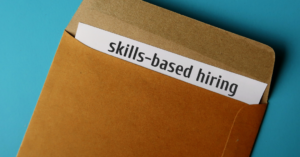What Is A Hiring Process and Why Do You Need One?
It is well-known that systems and the people who manage them build businesses. Therefore, logically, the most critical systematic approach should facilitate the hiring process as specifically and seamlessly as possible.
From knowing the vision and mission of the company and the ideal skill sets and people to fill those roles to working with an internal or external recruitment team to interviews, background checks and successful onboarding.
Your Hiring Checklist
This report shares a fundamental checklist. You may add more steps, though we suggest you don’t reduce them.
Create your checklist proactively, well in advance of any hiring needs. Identify the essential characteristics and traits required for the role and ensure they remain a focal point during the interviewing and onboarding phases.
The effectiveness of your hiring process directly impacts your ability, to pinpoint and onboard candidates who will deliver and grow in their roles. Conversely, it dictates whether you’ll waste time, funds, and resources on unsuitable hires.

- Identify Which Roles You Need To Fill
The need for new hires could come from a vacant position or the need to add to a team to manage better workload performance or to expand. Open positions may be due to new jobs added, recently vacated positions or departing team members.
You may have plenty of notice before a position opens, depending on the circumstances. Responsible people in critical roles usually make an exit plan. However, sometimes vacancies can’t be anticipated.
To identify which positions you need to fill, meet with your internal team to review openings. Following a hiring process checklist ensures that your time-to-fill is shortened and your process remains consistent.
- Establish Your Budget Timeline and Recruitment Partner
For each new role, determine your offer based on salary benchmarking data and market expectations. Identify and work with a specialist like us Ice Recruitment, who understands the current market.
Such a partner will be able to help you with your talent acquisition goals now and in the future and will be able to give you accurate ideas on realistic packages and timelines.
To speed up the process and hire more efficiently, utilise success profiles for each critical job role. You can establish baselines by analysing and assessing your top-performing employees and determining the traits and characteristics most vital to success in the role.
- Create A Job Description
Job descriptions serve several vital purposes for employers:
- Clarity: They clearly define a particular job’s responsibilities, duties, and expectations. This clarity helps both the employer and potential candidates to align their expectations.
- Selection Criteria: They provide a framework for assessing an applicant’s suitability for the role based on specific qualifications and requirements.
- Legal Compliance: It can help ensure legal compliance by clearly outlining essential job functions, qualifications, and other pertinent employment law information.
- Performance Evaluation: A benchmark for evaluating employee performance.
Your recruitment partner can play a crucial role in helping you create compelling job descriptions. They have market insight and extensive experience writing them.
Promote Your Job on Multiple Channels
Depending on whether you are using a recruitment partner or your own internal talent acquisition team, it is vital to use multiple channels to promote your vacancy.
The upside of an external recruitment company like Ice is they have often mapped the market and already have a database of potential candidates with a suitable skill set.
For other roles, ensure you post on your website, social media, related job boards, and more than once on social channels.
- Decide on The Interview Process and Format
The interview process must be consistent for each. If this is your first time using Ice Recruitment ask us how our process can support you.
- When reviewing your process, here are some things to consider.
- Does the role in question require key skills and experience? If so, what are they, and how will you assess them before and during the interview? What are the must-haves that your recruiter or TA team need to know?
- Will psychometric testing form part of the process or not? Will the interview involve telephone, video, or onsite interviews?
- How many stages will there be, and what timelines will you work to?
- Be aware that the more stages you have in your process and the longer the timescale, the more likely you will be that the ideal candidate will be offered alternate roles by companies that act faster.
- What will be the core questions you ask at the interview related to the job description and culture fit you are looking for?
- Create an Administration Review and Short List Process
When managing your hiring, once applications start to arrive, have a process in place to match their key skills and experience related to the job description to avoid using valuable interview time when applicants don’t have the skills you require.
In the current marketplace, where poor feedback can go viral, ensure you have an appropriate and polite process for giving candidates relevant feedback.
From the initial applications, create your shortlist and inform them of your interview process and expected timelines.
- Create Your Interview Process and Review
In recent years, Zoom and Team meetings have super-seeded the classic telephone screening for many employers.
This is a crucial part of the process where you can confirm the candidate’s qualifications, ask for
Depending on your original ‘must-haves,’ decide which candidates will move to the next stage of your process.
Ensure that your process is DEI compliant.
Know the specific questions you will ask that relate to the job description and the ideal competencies and behaviours you want in an employee.
8. Next Stage Interviews
As you move onto the next stage of the interview process, agree on who will or won’t be present and confirm your criteria for deciding who will be employed.
- In-person interviews have changed as technology improves, and remote and hybrid work has become more common.
- Many businesses use only video interviewing, while others use a pre-screening interview via video followed by an in-person interview, which will depend on your company.
- Whether interviewing in person or via video, asking practical questions is essential.
- Regarding stage seven, agree on the questions you will ask and your scoring criteria.
- Jot down notes and impressions during the interview to make the assessment easier for the next step.
- Agree on Which Candidate Will Be Hired According to Your Criteria
You may have a one or two-stage interview. Depending on which you decide, here you will assess who moves to the next stage, why or who will be offered a role, and what that offer will include.
- Perform Background Checks
By this step, you have chosen your primary candidate, and at least one backup candidate in case your first choice falls through.

11. Make Your Job Offer
Once you’ve settled on the candidate, you must create your offer. In addition to salary, it should include details of additional benefits.
In today’s market, candidates may consider other jobs, so make sure your offer is competitive and avoid time delays in making your decision. It’s not uncommon for good candidates to consider multiple offers at once.
The candidate may want to negotiate, which can be handled by the recruitment/search company you are working with. When you’ve worked out the details, formalize/ formalise your agreement with a contract.
- Notify Unsuccessful Candidates and Provide feedback
Following up with applicants who did not get the job is essential. Replying is a common courtesy after the interview process.
If a candidate could have improved in certain areas, needed more experience, or did not communicate well, this is all valuable feedback for both the candidate and the recruiter.
- Start The Onboarding Process When The Candidate Says Yes
In today’s marketplace, people move jobs regularly, and a poor onboarding process can result in good employees leaving. We hear horror stories about how individuals are treated after they say yes.
Having no contact with a future employer after accepting a job offer is incredibly common and gives a poor impression. A Zoom or phone call to check in or being invited to meet the team helps to settle your new recruit.
Some candidates had even shared that on their first day, they did not have a desk or chair when they arrived or, in some cases, no PC. And yes, sadly, this still occurs.
With many individuals working a notice period of weeks rather than days, there is no need for this to happen.
Create your onboarding process with check-in points before your new employee arrives, including the practical logistics of what needs to be ordered or set up so they are ready to go from day one.

- Onboarding, Probation and Performance Objectives
Finally, your new hire reports for their first day of work. In the early stages, it’s important to make them feel welcome so they know they have made the right choice in joining your company.
Human beings are success-seeking creatures, and we want to do well.
It might surprise you, but giving your new employees an understanding of how their role contributes to the business and clear direction on what they will be doing in their first few months and your expectations on performance helps.
Most employers have a probation/trial period to ensure the employee adapts to the job, which usually lasts three to six months.
Communicate your expectations and the results you want your new hire to achieve.
Checklist
Create a checklist to monitor the new employee’s progress during their probation/trial period related to specific goals you have set. Arrange regular meetings with them to discuss progress and any support they need. If you want a highly motivated and engaged employee, do this weekly.
To improve the process, ensure they have the ongoing training and support they need after the initial probation/trial period, and set performance objectives related to the role.
Below, we have listed the 15 key tasks for a hiring checklist that will work for you and your organisation.

Click here for a PDF of the Hiring Checklist to be sent to you directly.
Hiring Checklist
- Identify Which Roles You Need To Fill
- Establish Your Budget Timeline and Recruitment Partner
- Create A Job Description/Specification
- Promote Your Job on Multiple Channels
- Decide on The Interview Process and Format
- Create an Administration Review and Short List Process
- Create Your Interview Process and Review
- Next Stage Interviews
- Agree on Which Candidate Will Be Hired According to Your Criteria
- Perform Background Checks
- Make Your Job Offer
- Notify Unsuccessful Candidates and Provide Feedback
- Start The Onboarding Process When The Candidate Says Yes
- Onboarding, Probation and Performance Objectives
Again, we at Ice are specialists, do connect or chat to either of us here. Neo or Rachel. We would love the opportunity to help you build your team and partner with your talent plans.



